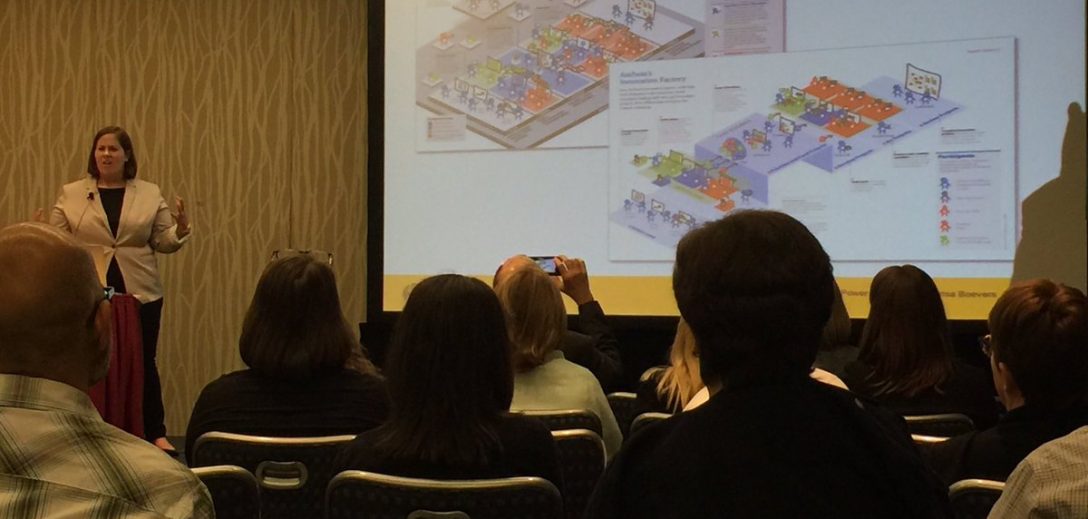Last week I had the opportunity to attend and speak at the International Association of Business Communicators (IABC) World Conference. It was a great few days in our national’s capital, filled with lively and stimulating conversation with some of the warmest and most out-going people you’ll ever meet. I presented about the problem of complexity and how ThoughtForm’s Six Clarity Methods can offer hope to business leaders and communicators. (If you missed my session and want to see an encore, register for our upcoming webinar on June 27).
During the question and answer portion of my session, an audience member asked a question about a topic I’m becoming more and more passionate about: attention span. I’ve received this question before and heard many, many other speakers and writers address it. How do you get a message across when your audience’s attention span is so short. And here’s my answer: I reject the premise of your question.
Every where you turn today, especially in internal communications, marketing, and training, you’ll hear people complain that their audiences’ attention spans are so short. They can’t sit through the presentation, they don’t read the memo, they won’t pay attention during the training. But I don’t think attention span is really the issue. The issue is that your content is boring, and there are many other, easily accessible distractions to get in your audience’s way. We all sit through movies (with a dozen coming attractions first), spend hours surfing the web, and have long chats with our friends and family. We are more than capable of paying attention to the same things for extended periods of time. The problem isn’t our attention spans. The problem is that it’s easier to pay attention to things that are interesting, particularly when the thing in front of you isn’t engaging.
Some people think the solution to this problem is to block out distractions. So they take away phones, ask participants to close laptops, and make other demands to ensure that the audience has one thing to focus on.
But, I have a different solution. My solution for everyone who writes, speaks, and communicates to audiences—especially business audiences: let’s make the content interesting!
Easier said than done, right? Agreed. Making messages interesting—especially information on subjects like compliance, financial reporting, and technical specifications, can be really difficult. The temptation with difficult and complex content is to focus on brevity. Just get in, tell the audience the bare minimum, and get out. But that’s exactly the wrong thing to do.
I’m a firm believer that no matter how seemingly mundane, technical, or minute a topic is, if you dig in deep and really understand it, it’s actually fascinating. So, we need to give our audiences more, not less. But we need to give them roads into the topic: by using real words, giving them the right kind of information, and structuring the topic with context. And there were some great examples of that at IABC World Conference this year.

To begin take the advice of the IABC World Conference opening keynote, speaker and writer Gabrielle Dolan, who is on a mission to eradicate jargon. She’s even starting a movement called Jargon Free Fridays. Dolan’s point about the nonsensical way businesses speak to their employees is a great one, and it goes right to the heart of making things interesting. Jargon is an understanding blocker. Speakers often rely on jargon when either they don’t understand the topic themselves or care more about appearing important or knowledgeable than sharing information. And you can’t make a topic interesting when you either don’t understand it or care more about appearances. So, drop the jargon and use real words to help your audiences really dive deep into your content.
Of course, all communicators want to give the right kind of information, but how do you know what’s right? On Tuesday, Simon Morton’s (@thepreslab) breakout session on creating presentations that connect with audiences reminded us that we must begin with the audience—and everything should flow from there. Morton shared a heat-map tool that he uses to plot how much factual, visionary, and emotional content each of his presentations should include. In the vein of making things interesting and diving deep, this heat map can help you to get the right balance of the who, what, where, when, why, and how.
Finally, context and structure are also key to helping audiences engage with theoretical content, especially things like business strategy. In his breakout session, Shawn Callahan (@ShawnCallahan) shared a strategy story structure that we can all use: “In the past it was [X], then [Y] happened, so now we are [Z], so the future will be [A, B, & C]. This structure helps to establish context, shows causalities, and focuses on concrete actions—all of which can make complex information more clear and make seemingly boring strategy more real.
So, as I head back to Pittsburgh from IABC World Conference this year, I’m taking the idea of making things interesting—not necessarily brief—to heart. And I hope that you can too. It won’t be easy, but with some thoughtful work and consideration, we can all make things more interesting.

